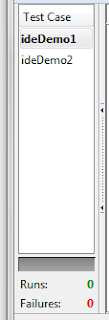Launch Firefox and Selenium IDE
Type the value for base url witch you need to automate. (Ex: http://www.seu.ac.lk/)
Select the record button to record (if already not selected)
In Firefox navigate to the http://www.seu.ac.lk/ url
To verify the page right click on any blank space within the page. Make sure not click on any hyperlinked objects or images. That will open the Selenium IDE context menu. In selenium IDE context it will show few commands. To get entire list select “Show Available Commands”
To verify the page right click on any blank space within the page. Make sure not click on any hyperlinked objects or images. That will open the Selenium IDE context menu. In selenium IDE context it will show few commands. To get entire list select “Show Available Commands”
Select “assertTitle South Eastern University of Sri Lanka - SEUSL” option. This is makes sure that the page title is correct.
Next Click at “life@SEU” link and verify the page title using the “verify title Life @ SEU | SEUSL” command
Next click on Blog link and there select the “Hello World”
Stop the recording by unselecting the record button. The script looks like below
Next click on Blog link and there select the “Hello World”
Stop the recording by unselecting the record button. The script looks like below
You can save the script using the Ctrl+ s or by selecting the save test case option in filemenu. Notice that file save in HTML format.
To check the stability of your script can use the play back option. Once you click the playback option it will execute the whole script. All the test steps would be color in green for the successful run. For unsuccessful execution or failure, the failed test step would be highlight in red. And the test case pane failure shows as 1.
To check the stability of your script can use the play back option. Once you click the playback option it will execute the whole script. All the test steps would be color in green for the successful run. For unsuccessful execution or failure, the failed test step would be highlight in red. And the test case pane failure shows as 1.
















